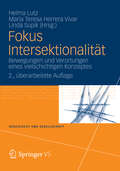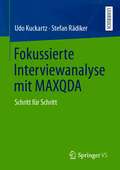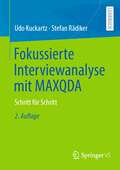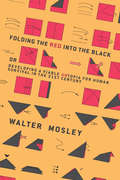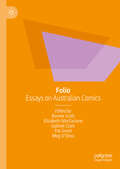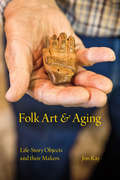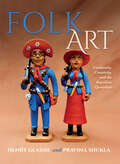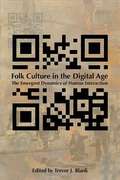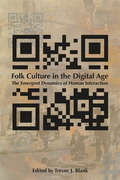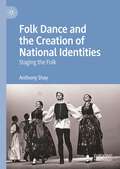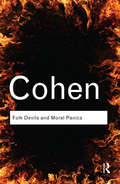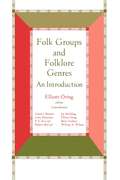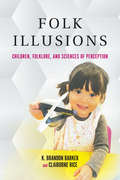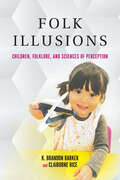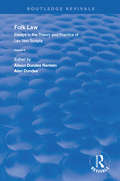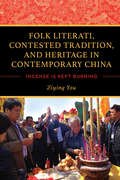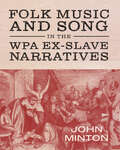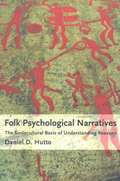- Table View
- List View
Fokus Intersektionalität
by Linda Supik Helma Lutz María Teresa Herrera VivarDie hier versammelten Beiträge spiegeln den aktuellen Stand der Debatte um Intersektionalität 20 Jahre nach Prägung des Begriffes im Schwarzen Feminismus in den USA. Bei seiner transatlantischen Reise durchlief der Ansatz Metamorphosen und fiel in Europa auf vorbereiteten Boden, insbesondere in anglophonen und deutschsprachigen feministischen Diskursen. Klasse, Geschlecht, Ethnizität und "Rasse", Sexualität, Behinderung, Alter und andere Dimensionen von Ungleichheit und Identität werden inzwischen in intersektioneller Perspektive untersucht. In diesem Band wird der Ansatz vorgestellt und in transdisziplinären und transnationalen Analyseperspektiven wie Diskurstheorie, Biographieforschung, Wissenssoziologie, Rahmenanalyse und Sozialstrukturanalyse verortet; auch werden kritische Interventionen zu Problemen und Grenzen dieses Konzepts diskutiert.
Fokussierte Interviewanalyse mit MAXQDA: Schritt für Schritt
by Udo Kuckartz Stefan RädikerQualitative Interviews erfreuen sich als Erhebungsmethode sehr großer Beliebtheit, wobei die Gesprächsgegenstände meist vorab festgelegt und in einem Leitfaden festgehalten werden. Die in diesem Lehrbuch vorgestellte fokussierte Interviewanalyse gibt detaillierte Empfehlungen, wie solche Interviewdaten systematisch und methodisch kontrolliert ausgewertet werden können. In sechs Schritten wird die praktische Vorgehensweise der fokussierten Interviewanalyse unter Einsatz der Software MAXQDA auf verständliche Weise beschrieben.
Fokussierte Interviewanalyse mit MAXQDA: Schritt für Schritt
by Udo Kuckartz Stefan RädikerEntdecken Sie in diesem Lehrbuch eine effektive Methode zur Auswertung qualitativer Interviews: die fokussierte Interviewanalyse. Erfahren Sie, wie Sie mit dieser spezifischen Anwendung der qualitativen Inhaltsanalyse Ihre Interviewdaten systematisch und methodisch kontrolliert auswerten können. In sechs einfachen Schritten wird Ihnen die praktische Vorgehensweise der fokussierten Interviewanalyse anschaulich vermittelt, unterstützt durch die effiziente Software MAXQDA. Erweitern Sie Ihre Forschungsmöglichkeiten und setzen Sie die fokussierte Interviewanalyse erfolgreich in Ihren Projekt um.
Folding the Red Into the Black
by Walter MosleyWalter Mosley is one of America's bestselling novelists, known for his critically acclaimed series of mysteries featuring private investigator Easy Rawlins. His writing is hard-hitting, often limned with a political subtext--aimed at a broad audience. When Mosley was working on a doctorate in political theory, he envisioned himself writing very different kinds of books from the ones he writes now. But once you've been tagged as a novelist, and in Mosley's case, a genre writer, even a bestselling one, it is hard to get an airing of ideas that cross those boundaries. Folding the Red into the Black has grown out of Mosley's public talks, which have gotten both enthusiastic and agitated responses. Mosley's is an elastic mind, and in this short monograph he frees himself to explore some novel ideas. He draws on personal experiences and insights as an African-American, a Jew, and one of our great writers to present an alternative manifesto of sorts: "We need to throw off the unbearable weight of bureaucratic Capitalist and Socialist demands; demands that exist to perpetuate these systems, not to praise and raise humanity to its full promise. And so I propose the word, the term Untopia. "
Folio: Essays on Australian Comics
by Elizabeth MacFarlane Ronnie Scott Gabriel Clark Pat Grant Meg O'SheaHow are Australian comics made and read? How do changes in comics and graphic storytelling over the past forty years intersect with our changing ideas about history, culture, community, creativity and technology? In Folio: Essays on Australian Comics, interdisciplinary scholars and world-leading makers pose questions about Australian comics, including through visual essays, asking how comics move out into community, industry, society, and disciplines both cognate and distant. It first examines the cultures and communities of Australian comics, from Indigenous cultural contexts to DIY zine fairs, and international markets to the graphic recording industry. It then focuses on practices and readings of individual comics, exploring individual practices and analysing Australian work, from government-commissioned comics with explicit social purpose to comics that employ augmented reality. Chapter 2 is available open access under a Creative Commons Attribution-NonCommercial-NoDerivatives 4.0 International License via link.springer.com.
Folk Art Potters of Japan: Beyond an Anthropology of Aesthetics (Anthropology of Asia)
by Brian MoeranThis is a study of a group of potters living in a small community in the south of Japan, and about the problems they face in the production, marketing and aesthetic appraisal of a kind of stoneware pottery generally referred to as mingei, or folk art. It shows how different people in an art world bring to bear different sets of values as they negotiate the meaning of mingei and try to decide whether a pot is 'art', 'folk art', or mere 'craft'.At the same time, this book is an unusual monograph in that it reaches beyond the mere study of an isolated community to trace the origins and history of 'folk art' in general. By showing how a set of aesthetic ideals originating in Britain was taken to Japan, and thence back to Europe and the United States - as a result of the activities of people like William Morris, Yanagi So etsu, Bernard Leach and Hamada Sho ji - this book rewrites the history of contemporary western ceramics.
Folk Art and Aging: Life-Story Objects and Their Makers
by Jon KayGrowing old doesn't have to be seen as an eventual failure but rather as an important developmental stage of creativity. Offering an absorbing and fresh perspective on aging and crafts, Jon Kay explores how elders choose to tap into their creative and personal potential through making life-story objects. Carving, painting, and rug hooking not only help seniors to cope with the ailments of aging and loneliness but also to achieve greater satisfaction with their lives. Whether revived from childhood memories or inspired by their capacity to connect to others, meaningful memory projects serve as a lens for focusing on, remaking, and sharing the long-ago. These activities often help elders productively fill the hours after they have raised their children, retired from their jobs, and/or lost a loved one. These individuals forge new identities for themselves that do not erase their earlier lives but build on them and new lives that include sharing scenes and stories from their memories.
Folk Art: Continuity, Creativity, and the Brazilian Quotidian
by Henry Glassie Pravina ShuklaListen to the artists of the Brazilian Northeast. Their work, they say, comes of continuity and creativity. Continuity runs along lines of learning toward social coherence. Creativity brings challenges and deep personal satisfaction. What they say and do in Brazil aligns with ethnographic evidence from New Mexico and North Carolina; from Ireland, Portugal, and Italy; from Nigeria, Turkey, India, and Bangladesh; from China and Japan. This book is about that, about folk art as a sign of human unity.
Folk Culture in the Digital Age
by Trevor J. BlankSmart phones, tablets, Facebook, Twitter, and wireless Internet connections are the latest technologies to have become entrenched in our culture. Although traditionalists have argued that computer-mediated communication and cyberspace are incongruent with the study of folklore, Trevor J. Blank sees the digital world as fully capable of generating, transmitting, performing, and archiving vernacular culture. Folklore in the Digital Age documents the emergent cultural scenes and expressive folkloric communications made possible by digital "new media" technologies.New media is changing the ways in which people learn, share, participate, and engage with others as they adopt technologies to complement and supplement traditional means of vernacular expression. But behavioral and structural overlap in many folkloric forms exists between on- and offline, and emerging patterns in digital rhetoric mimic the dynamics of previously documented folkloric forms, invoking familiar social or behavior customs, linguistic inflections, and symbolic gestures. Folklore in the Digital Age provides insights and perspectives on the myriad ways in which folk culture manifests in the digital age and contributes to our greater understanding of vernacular expression in our ever-changing technological world.
Folk Culture in the Digital Age: The Emergent Dynamics of Human Interaction (G - Reference,information And Interdisciplinary Subjects Ser.)
by Trevor J. BlankSmart phones, tablets, Facebook, Twitter, and wireless Internet connections are the latest technologies to have become entrenched in our culture. Although traditionalists have argued that computer-mediated communication and cyberspace are incongruent with the study of folklore, Trevor J. Blank sees the digital world as fully capable of generating, transmitting, performing, and archiving vernacular culture. Folklore in the Digital Age documents the emergent cultural scenes and expressive folkloric communications made possible by digital “new media” technologies. New media is changing the ways in which people learn, share, participate, and engage with others as they adopt technologies to complement and supplement traditional means of vernacular expression. But behavioral and structural overlap in many folkloric forms exists between on- and offline, and emerging patterns in digital rhetoric mimic the dynamics of previously documented folkloric forms, invoking familiar social or behavior customs, linguistic inflections, and symbolic gestures. Folklore in the Digital Age provides insights and perspectives on the myriad ways in which folk culture manifests in the digital age and contributes to our greater understanding of vernacular expression in our ever-changing technological world.
Folk Dance and the Creation of National Identities: Staging the Folk
by Anthony ShayThis book is about the folk: the folk in folk dance, the folk in folklore, the folk in folk wisdom. When we see folk dance on the stage or in a tourist setting, which is the way in which many of us experience folk dance, the question arises are these the “real folk” performing their authentic dances? Or are they urban, well trained, carefully-rehearsed professional dancers who make their livelihood as representatives of a specific nation-state acting as the folk? Or something in between? This study delves more deeply into the folk, their origins, their identities in order to know the source of inspiration for ethno identity dances - dances prepared for the stage and the ballroom and for public performances from ballet, state folk dance ensembles and their amateur emulators, immigrant folk dance group performances, and tourist presentations. These dances, unlike modern dance, ballet, or most vernacular dances, always have strong ethnic references. It will also look at a gallery of choreographers and artistic directors across a wide spectrum of dance genres.
Folk Devils and Moral Panics in the COVID-19 Pandemic (The COVID-19 Pandemic Series)
by Cosimo Marco Scarcelli Morena Tartari Cirus RinaldiFolk Devils and Moral Panics in the COVID-19 Pandemic analyses the phenomena of moral panics surrounding so-called folk devils in the context of the COVID-19 pandemic.In this volume, internationally recognised moral panic scholars from disciplines including sociology, media studies, criminology, and cultural studies examine case studies of moral panics related to the COVID-19 pandemic. These analyses consider the different social, political, economic, organisational, and cultural contexts within which such moral panics emerged and assess how the concept of moral panic can be deployed to offer novel insights into sociocultural responses to the outbreak. By utilising both classical approaches to moral panic analysis and more recent trends, chapters discuss the utility of the concept of moral panic that is, for the first time, applied to a global-scale event like the COVID-19 pandemic.This volume will be of interest to students and scholars in the social sciences with an interest in moral panics, responses to the COVID-19 pandemic, and the media and popular culture.
Folk Devils and Moral Panics: The Creation Of The Mods And Rockers (Routledge Classics)
by Stanley Cohen'Richly documented and convincingly presented' -- New Society Mods and Rockers, skinheads, video nasties, designer drugs, bogus asylum seeks and hoodies. Every era has its own moral panics. It was Stanley Cohen’s classic account, first published in the early 1970s and regularly revised, that brought the term ‘moral panic’ into widespread discussion. It is an outstanding investigation of the way in which the media and often those in a position of political power define a condition, or group, as a threat to societal values and interests. Fanned by screaming media headlines, Cohen brilliantly demonstrates how this leads to such groups being marginalised and vilified in the popular imagination, inhibiting rational debate about solutions to the social problems such groups represent. Furthermore, he argues that moral panics go even further by identifying the very fault lines of power in society. Full of sharp insight and analysis, Folk Devils and Moral Panics is essential reading for anyone wanting to understand this powerful and enduring phenomenon. Professor Stanley Cohen is Emeritus Professor of Sociology at the London School of Economics. He received the Sellin-Glueck Award of the American Society of Criminology (1985) and is on the Board of the International Council on Human Rights. He is a member of the British Academy.
Folk Groups And Folklore Genres
by Elliott OringOring's introductory folklore text consists of a series of essays by leading scholars that give the student a solid sense of major folklore topics and interpretive techniques. Since 1986, when it was first published, this book has met the need for good instructional material at a time of tremendous growth in folklore programs and introductory courses in colleges and universities around the world.
Folk Groups And Folklore Genres: An Introduction
by Elliott OringOring's introductory folklore text consists of a series of essays by leading scholars that give the student a solid sense of major folklore topics and interpretive techniques. Since 1986, when it was first published, this book has met the need for good instructional material at a time of tremendous growth in folklore programs and introductory courses in colleges and universities around the world.
Folk Illusions: Children, Folklore, and Sciences of Perception
by K. Brandon Barker Claiborne RiceWiggling a pencil so that it looks like it is made of rubber, "stealing" your niece's nose, and listening for the sounds of the ocean in a conch shell– these are examples of folk illusions, youthful play forms that trade on perceptual oddities. In this groundbreaking study, K. Brandon Barker and Clairborne Rice argue that these easily overlooked instances of children's folklore offer an important avenue for studying perception and cognition in the contexts of social and embodied development. Folk illusions are traditionalized verbal and/or physical actions that are performed with the intention of creating a phantasm for one or more participants. Using a cross-disciplinary approach that combines the ethnographic methods of folklore with the empirical data of neuroscience, cognitive science, and psychology, Barker and Rice catalogue over eighty discrete folk illusions while exploring the complexities of embodied perception. Taken together as a genre of folklore, folk illusions show that people, starting from a young age, possess an awareness of the illusory tendencies of perceptual processes as well as an awareness that the distinctions between illusion and reality are always communally formed.
Folk Illusions: Children, Folklore, and Sciences of Perception
by K. Brandon Barker Claiborne Rice“[A] well-researched and well-written book . . . linking traditional folklore studies to current scientific research and to thinking about human behavior.” —American Journal of PlayWiggling a pencil so that it looks like it is made of rubber, “stealing” your niece’s nose, and listening for the sounds of the ocean in a conch shell—these are examples of folk illusions, youthful play forms that trade on perceptual oddities. In this groundbreaking study, K. Brandon Barker and Claiborne Rice argue that these easily overlooked instances of children’s folklore offer an important avenue for studying perception and cognition in the contexts of social and embodied development. Folk illusions are traditionalized verbal and/or physical actions that are performed with the intention of creating a phantasm for one or more participants. Using a cross-disciplinary approach that combines the ethnographic methods of folklore with the empirical data of neuroscience, cognitive science, and psychology, Barker and Rice catalogue over eighty discrete folk illusions while exploring the complexities of embodied perception. Taken together as a genre of folklore, folk illusions show that people, starting from a young age, possess an awareness of the illusory tendencies of perceptual processes as well as an awareness that the distinctions between illusion and reality are always communally formed.“With clear focal points, sound and carefully explained methodology, and thought-provoking, substantial analysis, this book makes an excellent contribution to children’s folklore and related fields.” —Elizabeth Tucker, author of Children’s Folklore: A Handbook“A compendium of perceptual illusions, gathered from performers across the country, sorted into formally related perceptual categories, and analyzed under various theories of perception.” —Journal of Folklore Research
Folk Law: Essays in the Theory and Practice of Lex Non Scripta: Volume II (Routledge Revivals #Vols. I & Ii)
by Alison Dundes Renteln Alan DundesOriginally published in 1994, Folk Law, a comprehensive two-volme collection of essays, examines the meeting place of folklore - the unwritten law of obligations and prohibitions that are understood and passed on - and jurisprudence. The contributors explore the historical significance and implications of folk law, its continuing influence around the globe, and the conflicts that arise when folk law diverges from official law. Valuable for students and scholars of law, folklore, or anthropology, Renteln and Dundes's extensive casebook marks a rare interdisciplinary approach to two important areas of research.
Folk Literati, Contested Tradition, and Heritage in Contemporary China: Incense Is Kept Burning
by Ziying YouIn this important ethnography Ziying You explores the role of the "folk literati" in negotiating, defining, and maintaining local cultural heritage. Expanding on the idea of the elite literati—a widely studied pre-modern Chinese social group, influential in cultural production—the folk literati are defined as those who are skilled in classical Chinese, knowledgeable about local traditions, and capable of representing them in writing. The folk literati work to maintain cultural continuity, a concept that is expressed locally through the vernacular phrase: "incense is kept burning." You's research focuses on a few small villages in Hongtong County, Shanxi Province in contemporary China. Through a careful synthesis of oral interviews, participant observation, and textual analysis, You presents the important role the folk literati play in reproducing local traditions and continuing stigmatized beliefs in a community context. She demonstrates how eight folk literati have reconstructed, shifted, and negotiated local worship traditions around the ancient sage-Kings Yao and Shun as well as Ehuang and Nüying, Yao's two daughters and Shun's two wives. You highlights how these individuals' conflictive relationships have shaped and reflected different local beliefs, myths, legends, and history in the course of tradition preservation. She concludes her study by placing these local traditions in the broader context of Chinese cultural policy and UNESCO's Intangible Cultural Heritage program, documenting how national and international discourses impact actual traditions, and the conversations about them, on the ground.
Folk Literati, Contested Tradition, and Heritage in Contemporary China: Incense Is Kept Burning
by Ziying You“Ground-breaking . . . has implications for recognizing the existence and value of local, grass roots intellectual agency elsewhere in China and the globe.” —Mark Bender, the Ohio State UniversityIn this important ethnography Ziying You explores the role of the “folk literati” in negotiating, defining, and maintaining local cultural heritage. Expanding on the idea of the elite literati—a widely studied pre-modern Chinese social group, influential in cultural production—the folk literati are defined as those who are skilled in classical Chinese, knowledgeable about local traditions, and capable of representing them in writing. The folk literati work to maintain cultural continuity, a concept that is expressed locally through the vernacular phrase: “incense is kept burning.”You’s research focuses on a few small villages in Hongtong County, Shanxi Province in contemporary China. Through a careful synthesis of oral interviews, participant observation, and textual analysis, You presents the important role the folk literati play in reproducing local traditions and continuing stigmatized beliefs in a community context. She demonstrates how eight folk literati have reconstructed, shifted, and negotiated local worship traditions around the ancient sage-Kings Yao and Shun as well as Ehuang and Nüying, Yao’s two daughters and Shun’s two wives. You highlights how these individuals’ conflictive relationships have shaped and reflected different local beliefs, myths, legends, and history in the course of tradition preservation. She concludes her study by placing these local traditions in the broader context of Chinese cultural policy and UNESCO’s Intangible Cultural Heritage program, documenting how national and international discourses impact actual traditions, and the conversations about them, on the ground.“One of the most important and far-reaching books of folklore scholarship today.” —Amy Shuman, author of Other People’s Stories
Folk Literature of the Yamana Indians
by Johannes Wilbert"In my opinion this project of publications devoted to folk literature of South America is of paramount importance. South American mythology belongs to the spiritual inheritance of mankind on par with the great masterpieces of Greek and Roman antiquity and of the Near and Far East. At the present time this material is scattered in numerous publications most of which are not easy to locate. It would do a great service to scholars all over the world and to the general public to have them collected in a series of volumes."--Claude Levi-Strauss "It is time we had a set of volumes containing good source material for those who wish to study South American indigenous narratives; I am also quite certain that many nonspecialists would be interested in original documents of this kind."--Gerardo Reichel-Dolmatoff
Folk Masters: A Portrait of America
by Barry Bergey Text by Barry Bergey. Photographs by Tom PichDiscover one hundred of the greatest folk artists practicing in the United States in Folk Masters: A Portrait of America. Over the past 25 years, photographer Tom Pich has traveled the country to the homes and studios of recipients of the National Endowment for the Arts’ National Heritage Fellowship, the highest honor given to folk and traditional artists in the US. His portraits give us a glimpse into their art, their process, and their culture. While each image tells a story on its own, Barry Bergey, former Director of Folk and Traditional Arts at the National Endowment for the Arts, provides further insight into the lives of each featured artist as well as the remarkable stories behind each photograph. Folk Masters honors again the extraordinary women and men who simultaneously take the traditional arts to new heights while ensuring their continuation from generation to generation.
Folk Music and Song in the WPA Ex-Slave Narratives (American Made Music Series)
by John MintonBetween 1937 and 1940 fieldworkers in the Works Progress Administration’s Federal Writers’ Project interviewed around 3,500 formerly enslaved people in North America, resulting in roughly 20,000 pages of still unedited and inadequately indexed typescript. These accounts—the WPA ex-slave narratives—are the most substantial collection by far of folklore and oral history gathered directly from enslaved people in America. It is arguably the single greatest body of African American folklore extant, and a significant portion is devoted to folk music and song. This book considers this treasure trove in all its relevant social, cultural, and historical contexts. Nineteenth-century Black folk music developed against the backdrop of North American slavery, the American Civil War, Emancipation, the Federal occupation of the South, and a successful white supremacist paramilitary and political insurgency that led to Federal withdrawal, officially sanctioned racial terror, and Southern apartheid. The WPA ex-slave narratives describe that history in remarkable detail. Despite their inestimable value, most of the ex-slave narratives remained unpublished until the late 1970s, being almost unknown except to folklorists. Even after publication, the collection’s sheer size was a barrier. Quoting extensively from the narratives and exhaustively annotated and indexed, this volume provides readers with detailed explanations and full references for every musical item or tradition featured in the ex-slave narratives. John Minton covers instrumental music and social dancing, spirituals and hymns, singing games and lullabies, ring plays and reels, worksongs, minstrel songs, ballads, war songs, slavery laments, and much, much more. Written for both specialists and general readers, with 134 illustrations, the book also offers a general overview of the ex-slave narratives, their contents, creation, and relation to the field of African American folklore as a whole.
Folk Music of Britain - and Beyond (Routledge Library Editions: Folk Music #5)
by Frank HowesOriginally published in 1969. Until the latter half of the nineteenth century, it was thought that England, alone among the European countries, and unlike Scotland and Ireland where collections of ballads and songs had already been published as early as the eighteenth century, had no important native tradition of music. The founding of the (English) Folk-Song Society in 1898, however, and the pioneering work of such collectors as Lucy Broadwood, the Reverend S. Baring-Gould and, later, Cecil Sharp uncovered a still flourishing folk culture. Since then interest in this subject has grown steadily, and the bibliography of publications of actual folk-songs and ballads is now huge. Frank Howes sets out a general and scholarly introduction, first examining in detail the history and origins of folk music and going on to show the nature and vast amount of the material, enforcing his arguments with a wealth of examples from around the world. His discussion of the differences of national idiom leads on to a comparison of British folk music with that of other European countries and America, in which he pays due attention to the Celtic and Norse traditions. Separate sections on balladry, carols, street cries, broadsides, sea shanties, nursery rhymes and instruments illustrate both the variety of folk music and the extent to which it permeates our national heritage.
Folk Psychological Narratives: The Sociocultural Basis of Understanding Reasons
by Daniel D. HuttoThis book provides an elaborate defence of the claim that our capacity to understand intentional actions in terms of reasons has a decidedly sociocultural basis. It advances and explicates the hypothesis that children only come by the requisite framework for such understanding and master its practical application by being exposed to and engaging in a distinctive kind of narrative practice.
